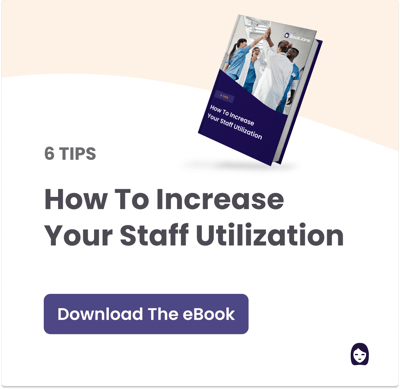
Efficiency Should Be The First Step In Combating The Staffing Shortage
According to recent studies, the pandemic has caused nearly 1 in 5 healthcare workers to quit their job. This, along with the 35% of nurses who say they have considered leaving their positions since the pandemic began - and the fact that other healthcare providers such as long term care facilities and nursing homes were already seeing problems with staffing prior to the the pandemic - has certainly put the industry in a staffing squeeze.
As administrators struggle with the increased cost of keeping facilities running, including paying out overtime rates to overburdened full time employees and relying on contract and agency hires to fill shifts, their organizations are seeing a decline in operating cash flow. Labor costs in healthcare are “driving expenses at a rate higher than revenue growth,” according to Brad Spielman, senior credit officer at Moody’s, and the situation is expected to continue over the next year - at least.
For healthcare organizations, finding a solution to these labor challenges isn’t just essential to patient care - it’s also a prerequisite to keeping your business running. Paying high agency costs isn’t sustainable over the long term, nor is overtime. So what is the solution? Paying attention to the efficiency of your workforce is key to both retaining your workers and sustaining your operations - and that starts with making good use of the staff you’ve already got on your payroll.
The Part-Time Workforce
While plenty of nurses and other healthcare workers have left their positions since the beginning of the pandemic, it doesn’t mean they’ve left the industry. In fact, healthcare workers were overrepresented among all workers paid by the hour and among workers working multiple jobs in a recent Statistics Canada study. Healthcare workers who are working part-time are often working in multiple facilities to pick up hours, and are typically looking for more.
Unlike full time employees, who are overscheduled and don’t want to work 60-80 hour weeks, part time staff are often willing to take on shifts and are interested in the receiving the flexibility to build their own schedule.
According to a study by the Canadian Women’s Foundation, Canada’s total employment dropped by more than 1 million at the onset of the pandemic, with over 10% of these jobs held by part-time care workers. Part timers, who are often working for multiple facilities and want more consistency from their schedule, are typically looking for hours. At points in the pandemic, part time staff working at multiple facilities were restricted to only one workplace, sometimes leaving them struggling to make ends meet.
Even now that restrictions have been lifted, many part timers are still looking for the stability of additional shifts - often from the same organizations so desperate for workers that they’re paying high fees for agency staff.

Efficiency Is the Solution
According to recent statistics, 32% of Canada’s nurses and 40% of PSW’s are part-time employees - which means that if you’re a healthcare organization, you likely have some of them on your payroll. In many organizations, the capacity to fill shifts is there, but not the process: care facilities are looking to bring on workers to cover shifts, and part time workers are available to work them. The disconnect between these two is inefficiency.
The healthcare sector has been slow to move to technology solutions. In an industry that still sometimes relies on pagers and faxes, there’s often reluctance to making changes to the established workflow. However, amidst the crunch of the pandemic, the traditional process for filling shifts is no longer working: when administrators need to contact staff one by one to fill a time slot, they not only take longer than they need, they could also miss the opportunity to fill the shift with a part-time staff member they already have, rather than paying inflating rates for an agency hire.
This means more consistency not just across staff, but also among the workforce overall: when part-time workers have more control over their schedule and are able to find consistent shifts, you have better odds of retaining them. “Sometimes you end up working in one location and then having to run across the city to another location to your job,” says one PSW interviewed by CBC. Better scheduling and more flexibility over hours for part time staff can reduce these scenarios, and the best way to do this is by automating the call-out process.
Organizations that use call-out tools such as J360 Workforce have an 85-95% success rate for filling shifts with existing workers, compared to just 45-55% in the traditional process (which usually means using agency help). This additional efficiency not only lowers agency costs and overtime fees, it also engages your part time workforce and gives them more control over their hours (something your competitors might not offer) which could mean less turnover. Letting staff know about an available shift through an email or text notification means you can both make it easier for your existing staff to pick up hours when they want them and reduce your agency spend, something efficient for both you and your workforce.
No matter what kind of healthcare services you provide, running a care organization isn’t easy. To survive the crunch, administrators will need to focus on making use of the resources they already have, giving staff more control over their schedules, and creating a better work/life balance for employees. A more efficient workplace means happier staff, lower costs, and better patient care - and this is good for everyone involved!




